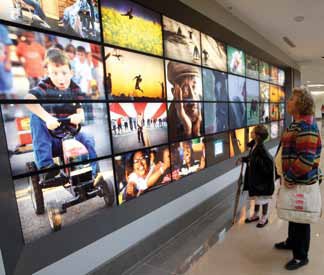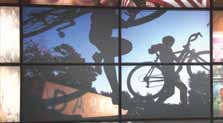Artful Video Wall Transforms University of Kentucky Health Care Center

The inspiring “Celebrate Kentucky” video wall has a transformative effect for University of Kentucky Health Care Center patients, visitors, and staff. The wall operates 18 hours a day, every day of the year. This creative tribute required best-in-class processing power and video flexibility. The University of Kentucky Health Care Center’s immense new “Celebrate Kentucky” multimedia wall offers patients and employees an ever-changing, complex snapshot that supports the center’s mission to care not only for the physical health, but for the spiritual and emotional well-being of patients. The Lexington center’s wall is a ninety-foot, thirty-two screen visual spectacle that commemorates life in Kentucky. The wall operates 18 hours a day, 365 days a year and features images and videos of people, places, animals, and life— from the microscopic to natural vistas. Local photographers and filmmakers refresh a constant stream of content for the high-impact wall.
“We were looking for a way to make a spectacular visual statement,” said University of Kentucky professor and project creative director, Tim Broekema. “And that meant making sure we had the latest cutting-edge display technology available.”
RGB Spectrum’s integration partner PSG Systems of Louisville, KY, designed and installed a display engine using five MediaWall 4200 video wall processors that feed thirty-two Samsung forty-two inch LCD panels. In addition, seventy-six Duratrans forty-two inch rear-lit transparency enclosures are integrated with the LCD screens to create a 90-foot wide by nine-foot high display wall. With high-resolution photographic transparencies on display, video and graphics image output by the processor needed to be reliably high-quality.

Synchronized video playback is provided by an Alcorn McBride Digital Binloop HD eight-channel digital video player which is connected HDMI-to-DVI to the MW-4200s. The outputs from the MW-4200s are encoded for UTP transmission via Magenta Research HD-ONE digital video extension kits.

System control is provided by an AMX NI-3100 Netlinx Integrated

The University of Kentucky Health Care Center’s “Celebrate Kentucky” visually communicates comfort, creativity, and empathy to passersby. The team behind the project believes that art and technology can positive contribute to wellness. master and NXV- 300 Modero Virtual Touch Panel. System power on/off and playback are fully automated per a user-defined schedule. The system’s electronics are located in the lower level of the facility and are housed in a Middle Atlantic MRK-4436 equipment rack provisioned with an RM-LCD-PNLK rack mount LCD panel, an RM-KB pull-out keyboard and a UPS-2200R uninterruptable power supply.
“One of the major design concerns was maintaining the image quality of video moving across large areas and multiple displays,” Kirby said. “The MW4200s allowed us to make fine adjustments to the mullion settings and window configurations to precisely fit the video playback to the displays. This resulted in a huge time savings and allowed the video editor to concentrate on the content.”
A daily selection of features, industry news, and analysis for tech managers. Sign up below.
RGB Spectrum’s display processors are used in a range of applications from control rooms to emergency operations centers to public displays such as the University of Kentucky Health Care Center’s ever-changing wall, which provides a spectacular tribute to the state of Kentucky.
AV INNOVATION IN KENTUCKY
Q&A with Tim Broekema
AV Technology: What was the strategy behind Celebrate Kentucky?

Tim Broekema: The University of Kentucky Health Care Center was building a new health pavilion to unify their five on-site hospitals, and they wanted to visually communicate comfort and empathy to people passing through, as part of the idea that art can be a positive contribution to health care.
Celebrate Kentucky does this by showing people video and still images of small slices of everyday life in Kentucky, adjusted to reflect the weather and seasons. For instance, if it is snowing outside, the Celebrate Kentucky visual shows scenes with snow. What we are really trying to do is to get viewers to connect with their own memories of Kentucky life, and to draw comfort from it.
AV Technology: Where did the content come from?
Broekema: They were taken by a small army of photographers and videographers from across the state, with more than 450 stills and video clips making the final edit. There are so many, that you can watch the installation for an extended period of time, and still not see them all. In fact, to see all of the imagery you would have to visit the hospital once during each season of the year.
The content and the AV equipment were funded by private donors, who gave the University about $1 million for me to work with. In all, UK raised about $5 million in private donations to purchase the more than 300 pieces and collections of art in the 1.2 million-square-foot hospital addition making the medical center become one of Kentucky’s notable art museums.
AV Technology: Why did you opt to use Duratrans?
Broekema; Budget reasons. Even with $1 million, we needed to keep costs down, due to the content creation costs. Originally, we had intended to have a full monitor wall, but that was simply not affordable. So using a mix of Duratrans and monitors — and changing the Duratrans images twice yearly, when we go from our Spring/Summer theme to our Fall/Winter theme — proved to be an effective solution. In fact, one the installation was in place I was happy that part of the imagery was static. It created an excitement against the visuals that were in motion on the video monitor space.
AV Technology: What is the ROI on this project?
Broekema: Given that it was built using donated funds, I’m not sure that we can apply the idea of return on investment to Celebrate Kentucky. That said, there is no doubt that the video wall has been hugely popular since we opened it in May of 2011. Art can have a transformative effect on the human spirit, which is important in a hospital setting — because a good attitude has an impact on patient recovery, and family/friend support. It is said that a picture is worth a thousand words, but if you visit the installation and see how patients react as images dance down the 100-foot space, that alone is worth a million dollars.
James Careless is an award-winning freelance journalist with extensive experience in audio-visual equipment, AV system design, and AV integration. His credits include numerous articles for Systems Contractor News, AV Technology, Radio World, and TV Tech, among others. Careless comes from a broadcasting background, with credits at CBC Radio, NPR, and NBC News. He currently co-produces/co-hosts the CDR Radio podcast, which covers the Canadian defense industry. Careless is a two-time winner of the PBI Media Award for Excellence.

